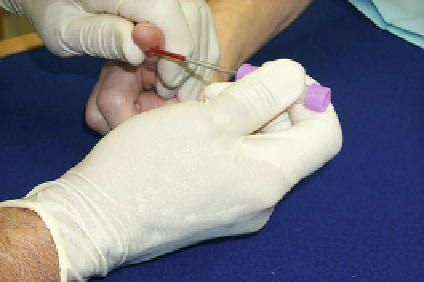Environmental Engineering Reference
In-Depth Information
When Biomonitoring is considered and adequate methods are available, the
objective of the study should be clearly defined. If the results will be used in
Human Health Risk Assessment, Toxicological Reference Values should exist for
the parameters measured. If the purpose of the assessment relates to prioritizing
human health risks in different areas, for example, attention should be paid to the
statistical boundary conditions for comparing population groups when interpreting
elevated body concentrations of contaminants.
As a negative side effect, sampling body fluids or body tissue might bring about
a socially and physiologically adverse impact on humans. Such an impact is hard to
quantify.
In practice, sampling of body fluids or body tissue is, although relatively costly,
possible and useful for a few contaminants. The most frequently used measure-
ment program relates to the measurement of
blood lead levels
(BLLs) in children,
which is representative for exposure during childhood, such as, for example, that
performed in Maynard et al. (
2003
) for sampling of lead in the blood of children in
South Australia. In Fig.
5.1
, a picture of the performance of a blood lead sampling
monitoring program is shown in response to community concerns of possible eleva-
tions in blood lead levels among the children of Anniston, Alabama, USA, during
spring 2001 (Thompson
2002
).
The current Critical Exposure value of lead in blood in children of 10
g/dL (e.g.,
Johnson and Bretsch (
2002
), who used blood concentrations higher than 10
μ
gdL
−
1
as the criterion for elevated blood levels at a contaminated site in Syracuse, USA).
This value of 10
μ
g/dL, although presently a subject of debate (e.g., Gilbert and
We i ss (
2006
), who claimed that blood lead levels below 10
μ
dL
−
1
may impair
μ
g
·
dL
−
1
is a useful and
feasible replacement), offers the possibility for appraisal of the measured blood lev-
els. One critical note about lead-blood sampling, however, is that lead-blood levels
are influenced by lead exchange between the blood and the bones, especially by
children, and there is debate about the residence time of lead in blood (Mushak
2003
).
neurobehavioral development and argued that a level of 2
μ
g
·
Fig. 5.1
The performance of
a blood lead sampling
monitoring program in
response to community
concerns of possible
elevations in blood lead levels
among the children of
Anniston, Alabama, USA,
during spring 2001 (source:
ATSDR; reproduced with
permission)

Search WWH ::

Custom Search